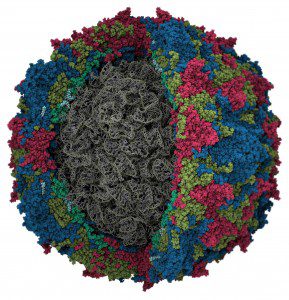

Poliovirus is the etiologic agent of the paralytic disease known as poliomyelitis. It’s also the virus I’ve worked on for most of my career. The World Health Organization is in the midst of a massive effort to eradicate the disease, an undertaking that has encountered a number of obstacles. In coming posts I’d like to discuss the polio eradication effort, but first we need some background on poliovirus.
Poliovirus is a member of a family of viruses called the Picornaviridae. Viruses are classified into families, and then genera, based on many criteria, including physical and biological properties. The Picornaviridae includes many other human pathogens, such as Coxsackieviruses, echoviruses, enteroviruses, hepatitis A virus, and rhinoviruses (which cause the common cold). The International Committee for the Taxonomy of Viruses is responsible for virus classification and maintains the Universal Virus Database, where you can find information about most known viruses.
Poliovirus is a rather small and simple virus. It is composed of a shell, or capsid, made of protein, as shown.
The poliovirus capsid is about 30 nanometers in diameter. Within the capsid is the information to make new virus particles – a single molecule of ribonucleic acid, or RNA. In the image, part of the capsid has been cut away to reveal the viral RNA. When the virus infects a cell, the RNA genome enters the cell and programs it to make new virus particles. These virus particles are released from the cell and go on to infect new cells.
In humans, poliovirus is ingested, and replicates in cells of the gastrointestinal tract. Newly synthesized virus particles are released into the intestine and shed in the feces. Transmission of poliovirus to another human occurs through contact with virus-containing feces or contaminated water. After multiplying in the gastrointestinal tract, poliovirus may enter the spinal cord and brain. Destruction of motor neurons by the virus leads to limb paralysis.
Poliomyelitis became a common disease at the turn of the 20th century. Two vaccines were developed in the 1950s that can effectively prevent the disease – inactivated poliovaccine (IPV, developed by Jonas Salk) and live, oral poliovaccine (OPV, developed by Albert Sabin). In 1988 the World Health Organization announced that it would eradicate poliomyelitis from the globe by the year 2000. We’ll discuss that goal, and obstacles that might prevent it from being attained, in subsequent posts.

Dr Racaniello,
Would it be possible to have a Polio molecular biology and pathogenesis (mice models) exclusive TWIV?
It is not my specific field of research but I am trying to get new venues for my future projects and a global vision from a expert like you may guide me.
Thanks for the blog,
David Loria
Is polio is retrovirus?
No, poliovirus is NOT a retrovirus. It is a picornavirus, a positive strand RNA virus encoding an RNA-dependent RNA polymerase. It does not make a DNA copy of the RNA genome.